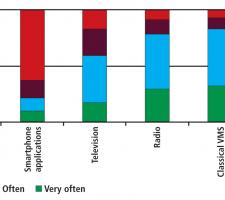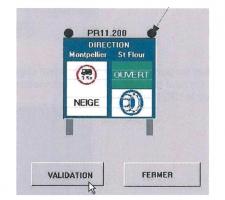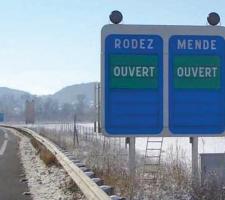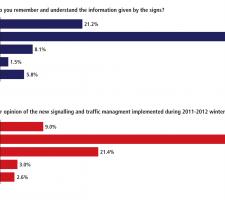
Alexis Bacelar
A survey into the effectiveness of weather-related variable message signs on a trans-mountain highway has some interesting results, as Alexis Bacelar told ITS Europe.
A study in theThe signs were deployed in three groups of two signs at four sites; Clermont-Ferrand, Lempdes (near Issoire) and Clermont-l’Hérault on the A75 motorway, and Séverac-le-Château on the 88 National Road. The signs indicated weather conditions and traffic limitations at various destinations including Clermont-Ferrand, St Flour, Aurillac, Mende, Rodez, Millau, Le Puy and Montpellier.
As the signs have now been in use for one or two winters, CERTU and MC DIR commissioned the ZELT group (Experimental Zone and Traffic laboratory of Toulouse) to evaluate the effectiveness of this equipment. The aim was to verify if the system meets the original objectives and to consider two specific areas: The first was a technical evaluation to see if the system works as expected, when and how it is implemented and if the signs are readable and understandable to road users. The second was an evaluation of the system’s impact on road users’ behaviour, the working conditions of the staff operating the system and those responsible for traffic management.
Analysis of the system implementation and the maintenance is carried out by analysing the use of road winter VMS and by interviewing traffic management operators and maintenance staff. The legibility and the understanding of the signs were assessed through surveys as was the acceptability of signs and their impacts on the user behaviour.
Researchers from the French National Laboratory PCI ESAD-ZELT analysed 429 replies which were divided into five user groups: drivers of particular vehicles; truck drivers; law enforcement officers; employees of the Centre of Exploitation and Intervention; and employees of the Centre of Engineering and Traffic management.
The means of information the most frequently used by the interviewees was gantry-mounted VMS followed closely by the radio (Figure 1). Winter road signs represent a close third, partly because the low usage during the mild winter of 2011-2012 (only 16 hours on average) influenced the numbers saying they used the signs ‘very often’.
Almost a third (32%) of drivers assessed visibility and legibility as ‘very good’ and 52% as ‘good’ while one in eight have an average rating and only 3% said they were ‘bad’. However 40% expressed difficulties reading the signs mainly linked to masking by other vehicles, usually trucks, while 17% cited masking by the snow. Other problems highlighted included the signs’ characters or pictograms being too small or displaying too much information. Some expressed difficulties caused by the juxtaposition of two signs for different destinations, the succession of three groups of closely sited signs and too much information to integrate in a short time.
More than half of the respondents (56%) believed the information on the signs while 22% believed the information was delayed or did not correctly anticipate the fast evolution of the traffic conditions. A further 14% considered the displayed limitations were more severe than the real traffic situation while 4% felt the opposite. However, for safety reasons, it is better to advise severe limitations than not enough tough ones.
Regarding the global appraisal of the winter VMS system, less than half of the respondents (234) expressed an opinion and of those who did, 73 % were satisfied or very satisfied. Even more, 88%, consider it useful or very useful in terms of safety or traffic information. Fewer than 6% were negative while 21% were indifferent.
On the technical side, the winter of 2011-2012 was mild so the winter road variable message signs were only activated, on average, approximately 16 hours. Findings on the maintenance requirements were distorted by numerous breakdowns of one particular sign in the city of Lempdes.
Law forces
The captains of the motorway squad of Issoire and Clermont l’Hérault said the signs are very legible and understandable but they would have preferred the signs’ to be mounted on gantries. The law forces also pointed out that the signs are situated on the plains, so the relationship with the traffic conditions in mountains is difficult to make and a reminder near the difficulties would be preferable.Local drivers rely on the signs and change their travel plans and routes accordingly while non-locals ask law forces which route they should take to bypass closed roads.
With regard to the signs impact on truck fleets, even when the signs carried a warning, many truck drivers continued to the point where the law forces closed the road and asked if they can pass. Law forces then explain the traffic conditions and, according to their destination, sort out trucks into those that need to U-turn, detour or park-up. Law forces in the southern part of the area consider that having seen the road in winter only 10-15% of truck drivers alter their routing to avoid restrictive measures ahead.
The procedures of truck storage or u-turn remain unchanged as is the number and nature of interventions. So overall the winter road VMS system did not reduce the workload on law forces.
Generally, most respondents expressed the view that the signs should be gantry mounted; the system is well appreciated by 75% of people who gave an opinion and is used in addition to classic VMS or radio. While local residents could use the information without further information, the lack of knowledge about alternative routes meant that many visitors and truck drivers didn’t change their travel plans according to the messages displayed.
While the signs are considered visible, readable and understandable, some considered they are positioned too far from the location of the problem.
The utilisation of winter road signs cannot be separated from the whole traffic management policy and from user information, although remote control from the Traffic Control Center (TCC) is useful as it reduces implementation time by half an hour.
Management of these signs has no strong consequences in term of workload for the traffic management and road operation agents although they can create some organisational difficulties in the coordination of the various departments.
In general, road operators would prefer classic VMS which could be used for purposes other than winter road conditions with a neutral default during summer rather than ‘opened’.
Alexis Bacelar works in the network design and management department of CERTU, the French scientific and technical network, and was assisted by Catherine Barthe and Louahdi Khoudou from the French National Laboratory PCI ESAD-ZELT
















